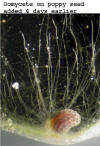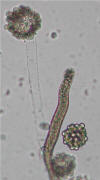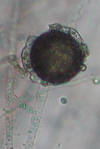





Appearing after 4 days in culture of standing dead vegetation (Apiaceae) on lettuce agar.
| Algae |
Protistan Fungi
Protostelid slime molds, Myxomycota, Dictyosteliomycota, Oomycota
Visit the global initiative to study diversity of slime molds and other "eumycetozoans"
| Protostelids | |
| Visit "A Beginner's Guide to Identifying the Protostelids" to learn more about this common but rarely seen group. |


 |
| Images at right are probably myxobacteria not protostelids. These images resemble protostelids in that no hyphae is associated with the fruiting structures, and the fruiting structure is stalked. However, the stalk is interesting and the orange color of the fruiting heads suggests myxobacteria. |


 Appearing after 4 days in culture of standing dead vegetation (Apiaceae) on lettuce agar. |
Moist Chamber Procedure for culturing slime molds from tree bark |
Other Links Slime Mold on log seen on Feb. field Trip. PhysarumPlus - see this site for more information and links to Physarum
|
Slime Molds in Human Affairs The Blob - Fuligo septica. Plasmodial slime molds occasionally appear in wood mulch in home gardens. The unsightly, thick "blobs" may cause distress to homeowners. "The Blob" appears locally (Florence, Alabama) in the wood chips used around children play structures. "The Blob" is typically Fuligo septica, visit the following web pages for striking photos Slime molds from Wayne's Word - best images of the dog vomit slime mold! Fuligo septica, the dog vomit slime mold, Tom Volk's Fungus of the Month for June 1999 - includes the pop hit song "The Blob"
Slime Molds on Turf Grass - Physarum cinereum. In the spring and early summer slime mold fruiting bodies are common in mowed lawns here in Florence, Alabama. The picture below was taken 6/8/99 from the campus lawn at UNA. Slime molds on turf grass are harmless. Physarum cinereum is the common species. For the most striking image of slime mold on grass blades see Botany Photo of the Day: Physarum cinereum
Slime Mold
Beetles, from
Cornell News: |
Science Buddies how-to-do-it for demonstrating maze-solving plasmodia |
| See
Images from ATBI slime mold research conducted by UNA students and faculty Cellular Slime Mould Tutorial - a great site to learn about (and see pictures and videos) the transformational stages in the life cycle of cellular slime molds (from dictyBase).
|
|
dictyBase Home - the online source for Dictyostelium information |
Protostelids, Myxomycetes, & Dictyostelids and are major subgroups of Eumycetozoans
The Oomycota, Plasmodiophorids, and Labyrinthulids are not eumycetozoans.
Easy Culture Method |
|
| Water mold development after
5 days from creek water, Dec. 30, 2010. A half piece of uncooked rice grain was the bait inserted into the microaquarium. The tips of many hyphae have developed into zoosporangia. The microaquarium is sitting atop an ordinary lampshade for backlighting.  |
|
| Oogonium with oospores coenocytic hyphae (click to enlarge image)  |
 |
| Achlya
|
 zoosporangia
zoosporangia
 young oogonium with antherdia attached
young oogonium with antherdia attached |
| [to be moved to Zygomycetes] Zoophagus insidians
|

 right image w/2 elongate "gemmae" and 2 trapped rotifers
right image w/2 elongate "gemmae" and 2 trapped rotifers |
| Links to other sites | Biology and Systematics of the Saprolegniaceae by Johnson, Seymour, and Padgett. 2002. |
| Plasmodiophorida | |
| Link to site devoted to plasmodiophorids | |
| Labyrinthulida | |
| Link to informative page on labryinthulids | |
| Algae |